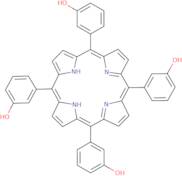
Product Information
- 3,3′,3′′,3′′′-(21H,23H-Porphine-5,10,15,20-tetrayl)tetrakis[phenol]
- 3,3′,3′′,3′′′-Porphyrin-5,10,15,20-tetrayltetraphenol
- 5,10,15,20-Tetra(3-Hydroxyphenyl)Porphyrin
- 5,10,15,20-Tetra(m-hydroxyphenyl)porphyrin
- 5,10,15,20-Tetrakis(3-hydroxyphenyl)porphyrin
- 5,10,15,20-Tetrakis(3′-hydroxyphenyl)porphine
- Phenol, 3,3′,3′′,3′′′-(21H,23H-porphine-5,10,15,20-tetrayl)tetrakis-
- Phenol, 3,3′,3′′,3′′′-(5,10,15,20-porphinetetrayl)tetra-
- Tetra(3-hydroxyphenyl)porphine
- m-THPP
- See more synonyms
- meso-Tetrakis(3-hydroxyphenyl)porphyrin
- phenol, 3,3',3'',3'''-(21H,22H-porphine-5,10,15,20-tetrayl)tetrakis-
3,3',3'',3'''-(Porphyrin-5,10,15,20-tetrayl)tetraphenol (HPT) is a porphyrin derivative that is structurally related to hematoporphyrin. HPT is unsymmetrical and can exist in two forms, depending on the pH of the environment. At low pH, HPT exists as a protonated form with an absorption maximum at 505 nm. When exposed to light, HPT undergoes photochemical reactions resulting in the generation of reactive oxygen species (ROS), which are capable of damaging DNA and other cellular macromolecules. Bacterial strains that were more resistant to this type of damage were found in cell culture studies. These bacteria are also able to uptake HPT into their cells and reduce it to hematoporphyrin IX (HpIX). The uptake of HPT by these bacterial strains was inhibited by hydrochlor
Chemical properties
Technical inquiry about: 3D-XAA11279 3,3',3'',3'''-(Porphyrin-5,10,15,20-tetrayl)tetraphenol
If you want to request a quotation or place an order, please instead add the desired products to your cart and then request a quotation or order from the cart. It is faster, cheaper, and you will be able to benefit from the available discounts and other advantages.





